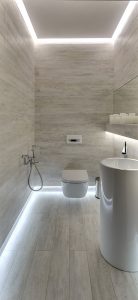For years now, LED lights have been outperforming fluorescent lights, and why is that? What are the benefits of LED lights in comparison to the traditional fluorescent lights? We will dive into the why LED lights are the much preferred choice of lighting for homes, offices, shops, stadiums, sky rises, and much more.
LEDs are known for their energy efficiency. They operate by converting electricity into light with minimal heat loss, whereas fluorescent lights produce light by exciting mercury vapor, which generates a considerable amount of heat. This difference in light conversion results in LEDs consuming significantly less energy to produce the same amount of light as fluorescent counterparts. In fact, LEDs can be up to 80% more energy-efficient than traditional fluorescent lights, making them the clear winner in terms of efficiency.
LEDs can endure for up to 50,000 hours or more. On the other hand, fluorescent lights typically last only around 10,000 to 15,000 hours. This huge difference in operating time translates to reduced maintenance costs and fewer replacements over time. LED bulbs can keep shining bright for years, providing consistent illumination without the hassle of frequent replacements required by fluorescent lights.

LEDs have a distinct advantage over fluorescent lights. Why? LEDs do not contain hazardous materials such as mercury, which poses significant risks to human health and the environment. Additionally, LEDs are more easily recyclable and contribute less to landfill waste. By choosing LEDs over fluorescents, individuals and businesses can reduce their carbon footprint and contribute to a cleaner, healthier planet.
Now in terms of the physical lights themselves, LEDs offer far more versatility in lighting design and application. They come in a variety of shapes, sizes, and colour temperatures, allowing for customisable lighting solutions to various needs and preferences. Furthermore, LEDs are instant-on and dimmable, providing greater control over brightness and ambiance compared to fluorescent lights, which often require warm-up time and have limited dimming capabilities. Whether it’s for residential, commercial, or industrial use, LEDs offer flexibility and adaptability that fluorescent lights cannot match.
